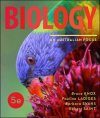About this book
Biology: An Australian Focus reflects on worldwide biological research and knowledge to provide a global outlook with Australian examples and cases woven throughout. Students are able to connect with what they're learning and better understand Australian flora/fauna and most importantly ecology & ecosystems, using this accessible and engaging learning resource. This fifth edition combines authoritative, peer-reviewed content with superior educational technology. Including a Connect package with interactive activities, animations, conceptual testbank and a full suite of instructor resources, and a newly developed, fully localised LearnSmart for a truly adaptive and personalised learning experience. The rich pedagogical layout layout of this text adds to the accessibility of the Biology: An Australian Focus learning package. As well as Concept Checks to provide students with the essential takeaway points for each section and help with exam revision, this edition also includes; Self-Assessment and Review and Analysis to test the students' understanding; Evaluation and Application to develop and test critical evaluation skills; and boxed case studies separated into Research, Application, Hot Topics and Focus features, to delve deeper into topics. Biology: An Australian Focus offers a complete learning package for all Australian biology students.
Contents
Part 1: Cell biology and energetics
Chapter 1: Nature of molecules
Chapter 2: Biomolecules
Chapter 3: The chemistry of life
Chapter 4: Functioning cells
Chapter 5: Movement across membranes
Chapter 6: Harvesting energy
Chapter 7: Cells, tissues and signals
Chapter 8: Cell division
Part 2: Genetics and molecular biology
Chapter 9: Inheritance
Chapter 10: Genes, chromosomes and DNA
Chapter 11: The genetic code
Chapter 12: Gene expression
Chapter 13: Genomes, mutation and cancer
Chapter 14: Viruses
Chapter 15: Genetic engineering and biotechnology
Part 3: Plant form and function
Chapter 16: Reproduction, growth and development of flowering plants
Chapter 17: Structure of plants
Chapter 18: Plant nutrition, transport and adaptation to stress
Chapter 19: Plant hormones and growth responses
Part 4: Animal form and function
Chapter 20: Animal reproduction
Chapter 21: Animal development
Chapter 22: Homeostasis: water, solutes and excretion
Chapter 23: Gas exchange in animals
Chapter 24: Circulation
Chapter 25: Metabolism, temperature regulation and environmental stress
Chapter 26: Animal and human nutrition
Chapter 27: Innate defences and the immune system
Chapter 28: Hormonal control in animals
Chapter 29: Nervous systems
Chapter 30: Animal movement
Chapter 31: Animal behaviour
Part 5: Evolution and biodiversity
Chapter 32: Evolving life
Chapter 33: Evolving earth
Chapter 34: Mechanisms of evolution
Chapter 35: Bacteria
Chapter 36: The protists
Chapter 37: Plants
Chapter 38: Fungi
Chapter 39: Simple animals: sponges to flatworms
Chapter 40: Annelids, molluscs, nematodes and arthropods
Chapter 41: Echinoderms and chordates
Part 6: Ecology
Chapter 42: Australian biota
Chapter 43: Population ecology
Chapter 44: Living in communities
Chapter 45: Ecosystems
Chapter 46: Human impacts Classification of cellular organisms
Units of measurement
Glossary
Index
Customer Reviews























